-
Car Reviews
- Car News
-
Car Comparisons
Latest comparisons
- Chasing Deals
The popular small SUV steps at last into the 2020s with a fresh new look, techier cabin and a more capable new platform
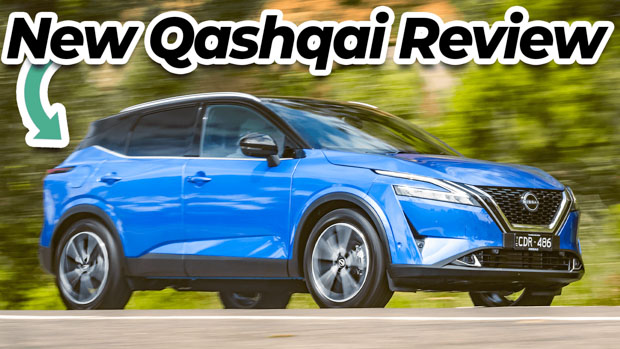
Two years after it was revealed in Europe, the new J12-generation Nissan Qashqai small SUV is finally ready for delivery to Australian buyers in a four-strong range that spans from the $33,890 ST base model to the flagship, $47,390 Ti grade on test.
It’s this flashiest of Qashqai trims that has taken the biggest leap into the 2020s, arriving in a fetching range of colours wrapping a higher-tech and quilted-leather interior – and looking pumped-up on big 19-inch alloy wheels.
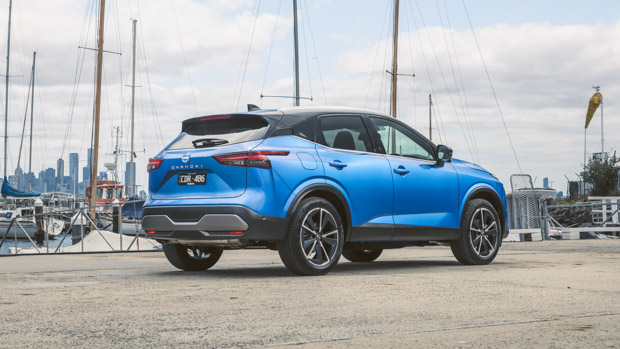
But for the circa $52,000-driveaway Qashqai Ti – and indeed for the entire range – you pay much more for the increased sophistication of the new-generation Mazda CX-30 and Toyota C-HR rival. Prices are up $8300 for the top grade version.
Thankfully, that cash goes towards a much more dynamically capable vehicle, with the Qashqai taking a thoroughly European route – adopting a stiffer, better platform, a small but torquier turbocharged petrol engine, and intuitive and modern cabin software.
Where the old Qashqai had more than a whiff of rental-car special about it, the new model feels altogether more chic, and is clearly more targeted towards private buyers in Australia than prior generations of Qashqai (née Dualis) may have been.
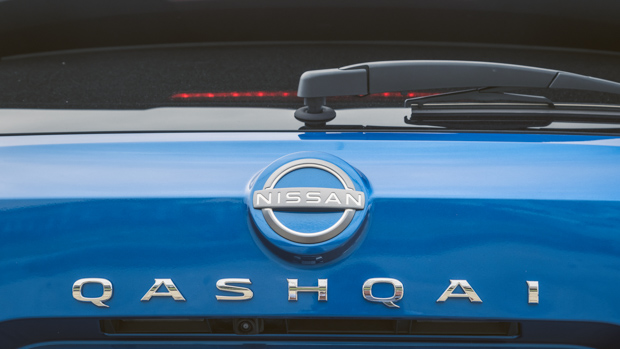
At the Qashqai’s national media preview in Melbourne, we were able to drive the Ti – which this test covers – and the one-rung-lower ST-L grade (about $45,000 driveaway). Beneath these sit the more workmanlike ST and ST plus models with plastic steering wheels and smaller alloys: these were not available to see or drive.
A rundown of 2023 Nissan Qashqai pricing can be found in this separate article.
The Qashqai has increased in price range-wide, though the increases for the entry-point versions are quite limited. The base model ST has gone up by $3300 or 11 percent to $33,890, while the Ti has escalated by a whopping 21 percent or $8300 to $47,390.
As a result, our expectations were high that the new Qashqai would be fitted with a wide range of desirable features – and that new engine – to help make up the difference.
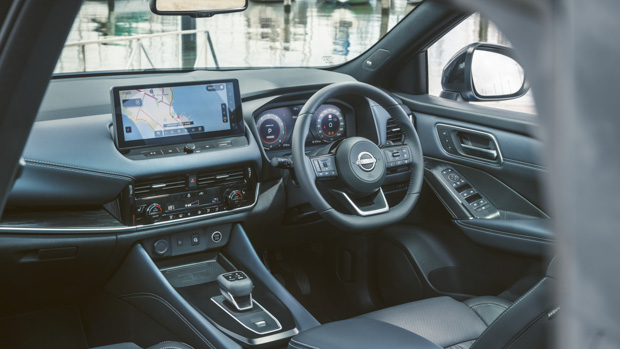
At the Ti level, this feels like a semi-premium SUV, with nice-to-haves like massaging seats and large screens-aplenty, though the lack of an opening sunroof or ventilated chairs are places where the car falls short against a Mazda CX-30 G25 Astina ($45,190).
As standard, the Qashqai Ti model scores the following feature list:
The only options relate to paint colours. The standard, or free, colour is magnetic blue metallic. Other colours attract a $700 premium, while two-tone paints – with a black or grey roof depending on colour – are $1200.
From the base ST grade upward, all Qashqais are equipped with:
This is not a facelift of the old Qashqai – it’s a rare instance in which a new model is a completely new car from the ground up. Nearly everything about the Nissan Qashqai has changed for 2023.
If you’ve got an older model of the same type, the most noticeable change will be the engine. Nissan has dispensed with the previous 2.0-litre non-turbo four-cylinder and replaced it with a 1.3-litre turbo that the brand shares with Renault and Mercedes-Benz.
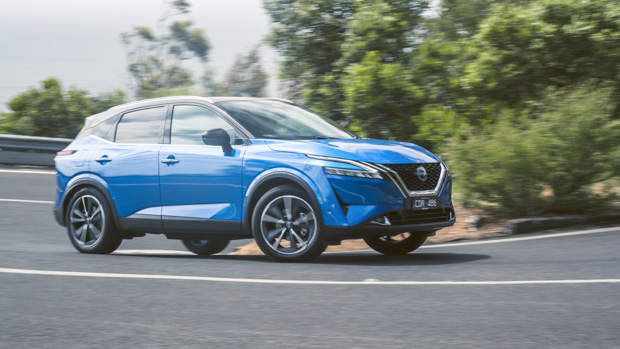
The engine itself might be smaller, but the addition of the turbo means that there’s much stronger performance on offer. Power has increased by 4kW to 106kW, but torque – which you feel more clearly while accelerating – is up 25 percent, from 200Nm to 250Nm.
That’s how the Qashqai feels out on the road: not fast, but definitely quicker, stronger and quieter while accelerating than the small SUV it replaces.
The more generous engine also makes for a much more peaceful partner to the Qashqai’s sole transmission: a one-speed CVT automatic.
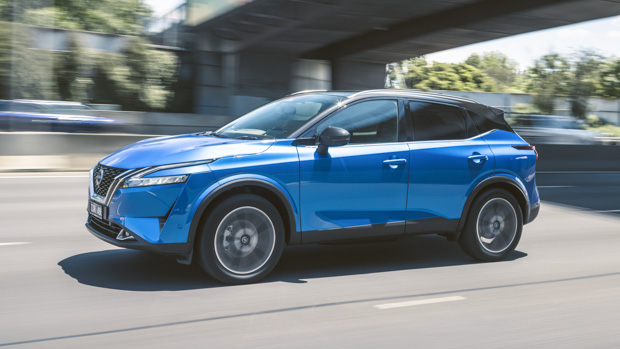
CVTs tend to cop a lot of flack from car testers, but the new-generation Jatco unit in the Qashqai seems competent and smooth – and because the engine has good torque, the engine RPMs don’t need to flare and blare so harshly. It’s very liveable.
Later, an even stronger Qashqai will arrive in Australia in the form of an E-power hybrid model, which will produce 140kW/330Nm. This rival to the Toyota Corolla Cross hybrid uses a novel petrol-electric system that uses a 116kW 1.5-litre engine mostly as a generator.
The other major change to the Qashqai is the swap to a relatively new platform from the Nissan-Renault family. Called CMF-C/D, this small to midsize car chassis makes the new Qashqai much more rigid and stiff.
Extra stiffness is a great advantage for the handling: the new Qashqai sits flatter in the bends and deals well with complex corners, while the steering feels more alive at urban speeds.
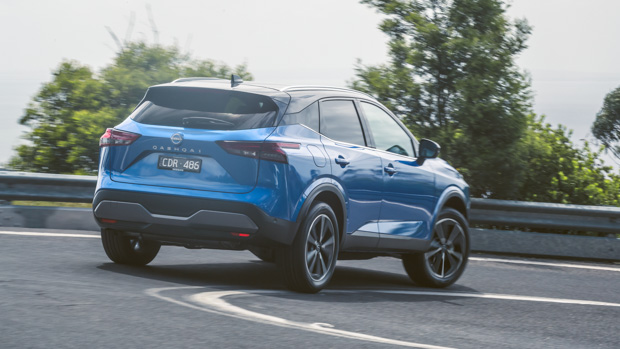
But one disadvantage is that securing the good handling has partially come at the expense of a much more focussed and firm ride quality than the softly-sprung old Qashqai.
The new Qashqai Ti sits on 19-inch wheels, though the 235/50 R19 tyres aren’t that low-profile. Our initial road test took in about 30km of higher-speed country roads with poor surfacing, and we found the ride to be very stiff.
But at lower speeds in town, this stiff ride was less apparent. If you are planning on doing a lot of country road driving where the roads have lots of potholes and sharp edges, a Mazda CX-30 or Skoda Karoq will be a comfier choice.
You could really tell that the previous-generation Qashqai was approaching a decade in age from its interior. While build quality was always impressive, the design and shapes of the components just looked early-2010s.
The new shape goes some way to addressing this – if not the whole distance. On the disappointing side of the ledger, the new Qashqai’s door card design still looks bland and the door pulls themselves could be 10 years old – plus some switchgear is very old-school.
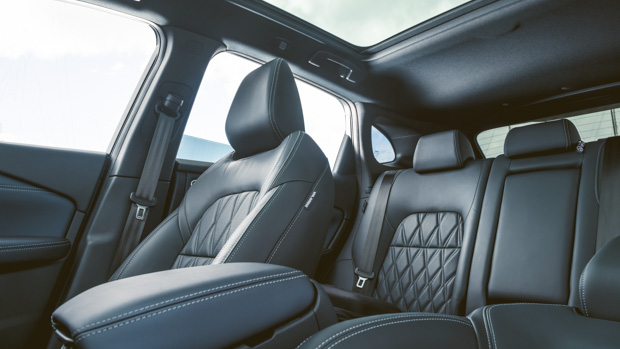
Thankfully, casting your eyes forward at the new dashboard reveals a much more contemporary aesthetic, with a really impressive and large landscape-orientated screen capturing lots of attention.
In the Ti grade on test, the big 12.3-inch middle screen pairs nicely with a digital driver display of the same size, lending an up-to-the-minute feel to the Nissan’s interior.
The screen hardware looks great, and the graphics and software that run through the display is also up to the task. Nissan’s new infotainment system is still pretty no-nonsense, but the resolution is high and wireless Apple CarPlay connectivity on test was rock-solid.
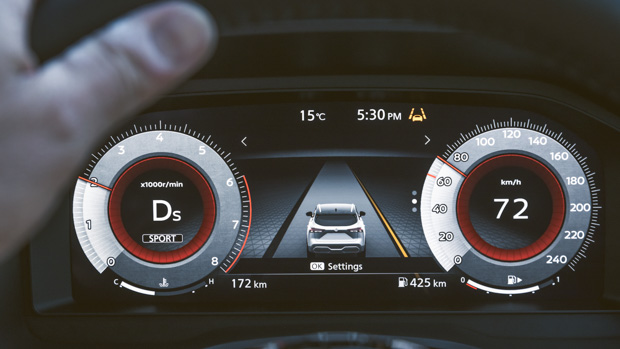
Plus, the exclusive-to-Ti Bose premium stereo sounds absolutely awesome, with crystal-clear fidelity that wouldn’t be out of place in a much more expensive SUV.
The colours used inside the Qashqai won’t be too all tastes, as the SUV has black seats and a navy-blue dashboard across the range – the same palette as some versions of Mazda’s CX-30.
We didn’t mind it, though, and the Ti’s fairly comfortable black leather seats with a luxe quilted pattern gave us decent support in the city. We’ll need to conduct a longer road test to see how they stack up after hours behind the (new) steering wheel.
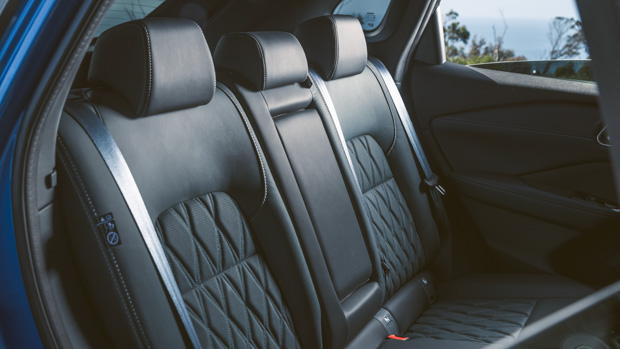
Moving to the back seat reveals a flexible amount of space for passengers. My six-foot frame fits comfortably beneath the fixed glass roof, and back-seat friends also have their own air vents and USB ports.
A 418-litre boot sits behind a power tailgate, though only the expensive Ti grade gets this convenient feature. The Ti also keeps to itself a cool divide-and-hide boot feature that lets you store items without them rolling around the space.
The cargo area itself is logical and square. Some rivals do have larger boots, however.
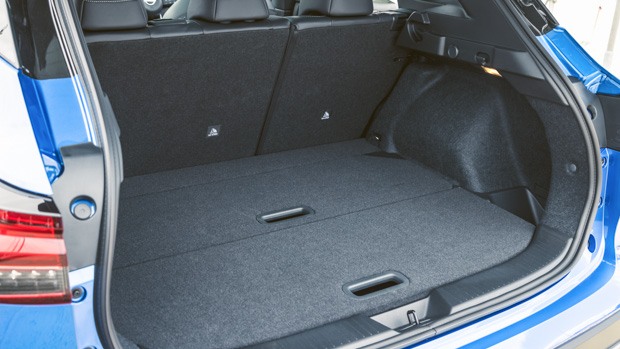
The new Nissan Qashqai was awarded a top five-star crash and safety rating by local testing body ANCAP. This was the result of a conversion of the Qashqai’s European crash testing process that was conducted by Euro NCAP in 2021.
In that crash test, the new Qashqai received the following scores:
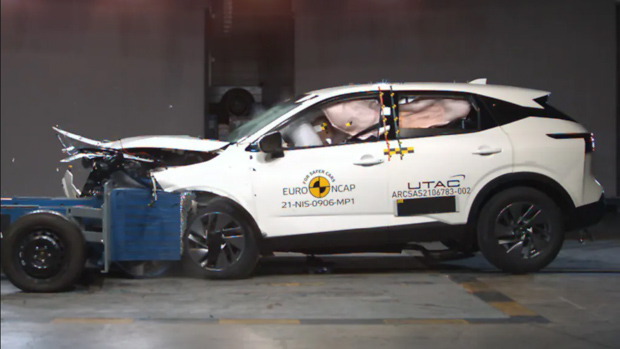
All versions of the Qashqai are fitted with autonomous emergency braking that operates while driving both forwards and in reverse. Plus, the forwards AEB detects pedestrians and cyclists (as well as cars), and operates when turning across junctions.
While Nissan has not been especially ambitious in Australia, in other markets it is energetically rolling out very advanced ‘Pro Pilot’ autonomous driving features.
We benefit indirectly from this global ambition, as the Qashqai’s adaptive cruise control and lane centring features are especially well-tuned.
Our launch route was mainly confined to Melbourne’s urban and suburban roads, so we can’t give a definitive answer about highway and rural driving yet. Nissan claims 5.3L/100km for higher-speed work.
What we can say is that against Nissan’s urban fuel economy claim of 7.5L/100km, we did 20 percent worse, recording a figure of 9.0L/100km. From its 55-litre fuel tank, our results would deliver an urban range of 611km.
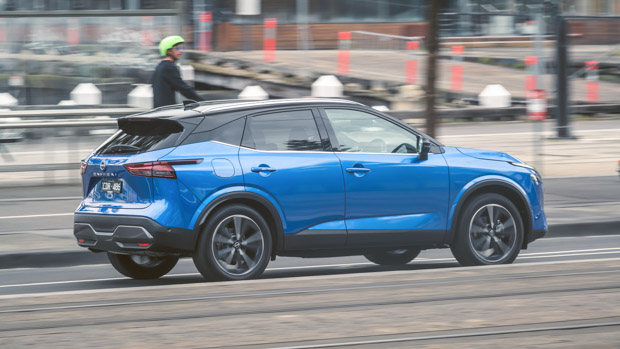
That’s pretty similar to a Kia Seltos or Hyundai Kona of similar size, but we’re not impressed – as hatchbacks like the Mazda 3 or Volkswagen Golf are much more economical on the same routes. Nissan no longer sells traditional hatches or sedans in Australia.
The Qashqai requires 95 octane premium petrol or higher.
When the Qashqai E-power hybrid arrives in Australia, expect it to deliver fuel consumption of more like 6L/100km.
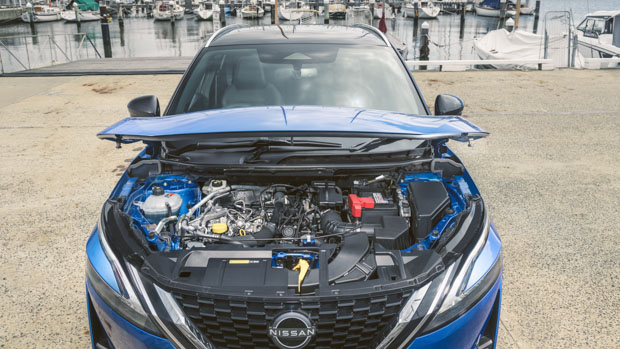
Scheduled maintenance is required every 12 months/15,000km for the Qashqai. Nissan operates a capped price servicing program, with the following schedule for this small SUV. The brand also has a pre-paid maintenance program which lets you secure today’s prices:
These prices look expensive compared to some rivals. The Toyota Corolla Cross demands just $1250 for five years/75,000km of servicing, while the Volkswagen T-Roc asks $2250.
Nissan sells the Qashqai with a five-year, unlimited-kilometre new car warranty in Australia.
The Nissan Qashqai was one of the very first small SUVs to be sold in Australia. Wearing Dualis badges in those days, the little Nissan crossover was a trailblazer in many ways.
Since that time in the late 2000s, the small-SUV market has become one of Australia’s hottest segments with nearly every car manufacturer vying for the attention of the buying public.
That is the new Qashqai’s biggest problem: the strength of many rivals that also deserve close consideration.
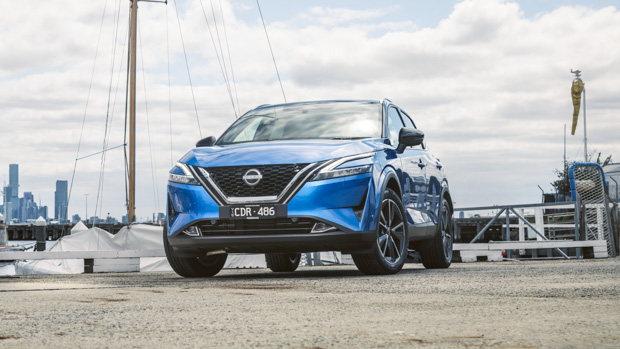
The new Nissan is solid to drive and we like the new turbo engine/CVT combination – but its fuel economy isn’t as sharp as we’d like to see. The incoming Qashqai hybrid could rectify this, albeit at a higher purchase price.
And we’re not yet convinced on the ride quality: we need to spend more time with the 2023 Qashqai before coming to a strong verdict on this element.
Certainly, though, the handsome new exterior design and more upmarket interior make life easier and better. The tech is easy to use and slick while this SUV is fun to drive.
It’s certainly worth putting on your list of test drives..
Key specs (as tested)
About Chasing cars
Chasing Cars reviews are 100% independent.
Because we are powered by Budget Direct Insurance, we don’t receive advertising or sales revenue from car manufacturers.
We’re truly independent – giving you Australia’s best car reviews.
The estimate provided does not take into account your personal circumstances but is intended to give a general indication of the cost of insurance, in order to obtain a complete quote, please visit www.budgetdirect.com.au. Estimate includes 15%^ online discount.
^Conditions Apply
Budget Direct Insurance arranged by Auto & General Services Pty Ltd ACN 003 617 909(AGS) AFSL 241 411, for and on behalf of the insurer, Auto & General Insurance Company Limited(ABN 42 111 586 353, AFSL 285 571).Because we don’t know your financial needs, we can’t advise you if this insurance will suit you. You should consider your needs and the Product Disclosure Statement before making a decision to buy insurance. Terms and conditions apply.
Indicative quote based on assumptions including postcode , 40 year old male with no offences, licence suspensions or claims in the last 5 years, a NCD Rating 1 and no younger drivers listed. White car, driven up to 10,000kms a year, unfinanced, with no modifications, factory options and/or non-standard accessories, private use only and garaged at night.
^Online Discounts Terms & Conditions
1. Discounts apply to the premium paid for a new Budget Direct Gold Comprehensive Car Insurance, Third Party Property Only or Third Party Property, Fire & Theft Insurance policy initiated online on or after 29 March 2017. Discounts do not apply to optional Roadside Assistance.
2. Discounts do not apply to any renewal offer of insurance.
3. Discounts only apply to the insurance portion of the premium. Discounts are applied before government charges, taxes, levies and fees, including instalment processing fees (as applicable). The full extent of discounts may therefore be impacted.
4. We reserve the right to change the offer without notice.